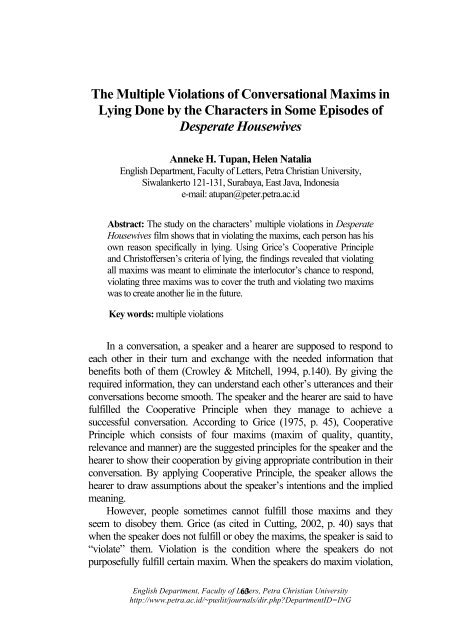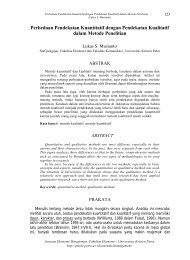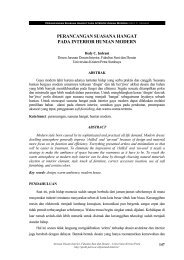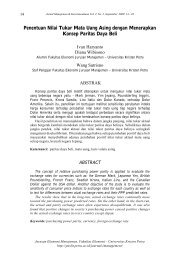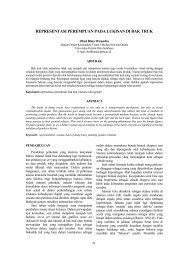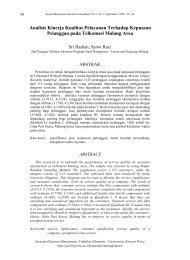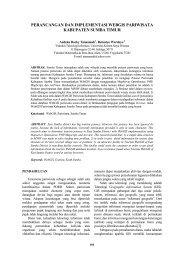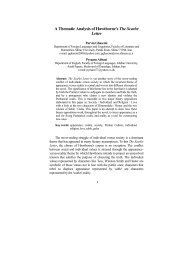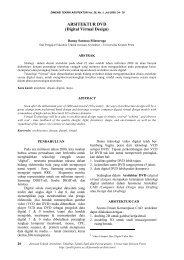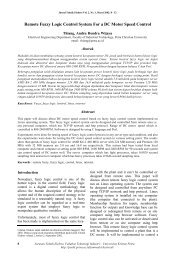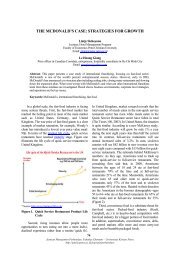The Multiple Violations of Conversational Maxims in Lying Done by ...
The Multiple Violations of Conversational Maxims in Lying Done by ...
The Multiple Violations of Conversational Maxims in Lying Done by ...
Create successful ePaper yourself
Turn your PDF publications into a flip-book with our unique Google optimized e-Paper software.
<strong>The</strong> <strong>Multiple</strong> <strong>Violations</strong> <strong>of</strong> <strong>Conversational</strong> <strong>Maxims</strong> <strong>in</strong><br />
Ly<strong>in</strong>g <strong>Done</strong> <strong>by</strong> the Characters <strong>in</strong> Some Episodes <strong>of</strong><br />
Desperate Housewives<br />
Anneke H. Tupan, Helen Natalia<br />
English Department, Faculty <strong>of</strong> Letters, Petra Christian University,<br />
Siwalankerto 121-131, Surabaya, East Java, Indonesia<br />
e-mail: atupan@peter.petra.ac.id<br />
Abstract: <strong>The</strong> study on the characters’ multiple violations <strong>in</strong> Desperate<br />
Housewives film shows that <strong>in</strong> violat<strong>in</strong>g the maxims, each person has his<br />
own reason specifically <strong>in</strong> ly<strong>in</strong>g. Us<strong>in</strong>g Grice’s Cooperative Pr<strong>in</strong>ciple<br />
and Christ<strong>of</strong>fersen’s criteria <strong>of</strong> ly<strong>in</strong>g, the f<strong>in</strong>d<strong>in</strong>gs revealed that violat<strong>in</strong>g<br />
all maxims was meant to elim<strong>in</strong>ate the <strong>in</strong>terlocutor’s chance to respond,<br />
violat<strong>in</strong>g three maxims was to cover the truth and violat<strong>in</strong>g two maxims<br />
was to create another lie <strong>in</strong> the future.<br />
Key words: multiple violations<br />
In a conversation, a speaker and a hearer are supposed to respond to<br />
each other <strong>in</strong> their turn and exchange with the needed <strong>in</strong>formation that<br />
benefits both <strong>of</strong> them (Crowley & Mitchell, 1994, p.140). By giv<strong>in</strong>g the<br />
required <strong>in</strong>formation, they can understand each other’s utterances and their<br />
conversations become smooth. <strong>The</strong> speaker and the hearer are said to have<br />
fulfilled the Cooperative Pr<strong>in</strong>ciple when they manage to achieve a<br />
successful conversation. Accord<strong>in</strong>g to Grice (1975, p. 45), Cooperative<br />
Pr<strong>in</strong>ciple which consists <strong>of</strong> four maxims (maxim <strong>of</strong> quality, quantity,<br />
relevance and manner) are the suggested pr<strong>in</strong>ciples for the speaker and the<br />
hearer to show their cooperation <strong>by</strong> giv<strong>in</strong>g appropriate contribution <strong>in</strong> their<br />
conversation. By apply<strong>in</strong>g Cooperative Pr<strong>in</strong>ciple, the speaker allows the<br />
hearer to draw assumptions about the speaker’s <strong>in</strong>tentions and the implied<br />
mean<strong>in</strong>g.<br />
However, people sometimes cannot fulfill those maxims and they<br />
seem to disobey them. Grice (as cited <strong>in</strong> Cutt<strong>in</strong>g, 2002, p. 40) says that<br />
when the speaker does not fulfill or obey the maxims, the speaker is said to<br />
“violate” them. Violation is the condition where the speakers do not<br />
purposefully fulfill certa<strong>in</strong> maxim. When the speakers do maxim violation,<br />
English Department, Faculty <strong>of</strong> Letters, 63<br />
Petra Christian University<br />
http://www.petra.ac.id/~puslit/journals/dir.php?DepartmentID=ING
64<br />
VOLUME 10, NUMBER 1, JUNE 2008: 63-78<br />
the conversation between the speakers and the hearers can be unsuccessful<br />
s<strong>in</strong>ce they will misunderstand each other. Speakers who violate a maxim<br />
cause the hearer not to know the truth and only understand the surface<br />
mean<strong>in</strong>g <strong>of</strong> the speaker’s words. In do<strong>in</strong>g so the speaker can violate more<br />
than one maxim at the same time and the writers later name it as the<br />
multiple violations.<br />
For some purposes, people tend to tell a lie. <strong>The</strong>y believe that a lie is<br />
the natural tool to survive and to avoid them from anyth<strong>in</strong>g that may put<br />
them <strong>in</strong> an <strong>in</strong>appropriate condition (Christ<strong>of</strong>fersen, 2005). However, the<br />
major purpose for people to tell a lie is that they want to save their face.<br />
Sometimes, when people do someth<strong>in</strong>g bad, they have no choice but lie to<br />
cover up their secret and to save their face. <strong>The</strong>re are many reasons for<br />
people to lie such as to hide the truth, to please the hearer, or maybe the<br />
speaker envies other people, and many others.<br />
Brown and Yule (1983, p. 32) give a further description on the<br />
conversational maxims proposed <strong>by</strong> Grice (1975, p. 45). Maxim <strong>of</strong><br />
quantity means that speakers should be as <strong>in</strong>formative as is required, that<br />
they should give neither too little <strong>in</strong>formation nor too much. Some speakers<br />
like to po<strong>in</strong>t to the fact that they know how much <strong>in</strong>formation the hearer<br />
requires or can be bothered with. People who give too little <strong>in</strong>formation<br />
risk their hearer not to be able to identify what they are talk<strong>in</strong>g about<br />
because they are not explicit enough. On the other hand, those who give<br />
more <strong>in</strong>formation than the hearer needs risk bor<strong>in</strong>g them. <strong>The</strong> effect <strong>of</strong> this<br />
maxim is to present that the statement is the strongest, or most <strong>in</strong>formative,<br />
that can be made <strong>in</strong> the situation.<br />
<strong>The</strong> second maxim is the maxim <strong>of</strong> quality, which says that speakers<br />
are, expected to be s<strong>in</strong>cere, to be say<strong>in</strong>g someth<strong>in</strong>g that they believe<br />
correspond to reality. <strong>The</strong>y are assumed not to say anyth<strong>in</strong>g that they<br />
believe to be false or anyth<strong>in</strong>g for which they lack evidence. Some<br />
speakers like to draw their hearer’s attention to the fact that they are only<br />
say<strong>in</strong>g what they believe to be true, and that they lack adequate evidence.<br />
<strong>The</strong> third maxim is the maxim <strong>of</strong> relevance, which says that speakers<br />
are assumed to be say<strong>in</strong>g someth<strong>in</strong>g that is relevant to what has been said<br />
before. While the fourth maxim is the maxim <strong>of</strong> manner, which says that<br />
speakers should be brief and orderly, and avoids obscurity and ambiguity.<br />
However, no one actually speaks like that the whole time; each<br />
conversation may conta<strong>in</strong> the purpose <strong>of</strong> the speakers. <strong>The</strong>se purposes can<br />
be good or bad both for the speakers and the hearers. Although Grice<br />
(1975, p.45) makes guidel<strong>in</strong>es for the speakers to be cooperative <strong>in</strong> hav<strong>in</strong>g<br />
English Department, Faculty <strong>of</strong> Letters, Petra Christian University<br />
http://www.petra.ac.id/~puslit/journals/dir.php?DepartmentID=ING
Tupan, <strong>The</strong> <strong>Multiple</strong> <strong>Violations</strong> <strong>of</strong> <strong>Conversational</strong> <strong>Maxims</strong><br />
conversation, sometimes people may disobey some maxims <strong>in</strong> order to<br />
achieve their purpose. A speaker can be said to violate a maxim when they<br />
know that the hearer will not know the truth and will only understand the<br />
surface mean<strong>in</strong>g <strong>of</strong> the words.<br />
If a speaker violates the maxim <strong>of</strong> quantity, they do not give the hearer<br />
enough <strong>in</strong>formation to know what is be<strong>in</strong>g talked about, because they do<br />
not want the hearer to know the full picture. <strong>The</strong> speaker is not imply<strong>in</strong>g<br />
anyth<strong>in</strong>g, they are “be<strong>in</strong>g economical with the truth”, for example:<br />
[<strong>The</strong> sett<strong>in</strong>g: A (a guest) wants to be nicer and friendlier, he smiles to B (a<br />
receptionist) and says hello politely. A dog comes and stands beside him.<br />
<strong>The</strong>n A asks B:]<br />
A : Does your dog bite?<br />
B : No<br />
A : (bends down to stroke it and gets bitten) Ow! You said your dog does<br />
not bite!<br />
B : That is not my dog.<br />
(Cutt<strong>in</strong>g, 2002, p. 40)<br />
B actually knows that A is talk<strong>in</strong>g about the dog which is beside B and<br />
not B’s dog at home, yet B <strong>in</strong>tentionally does not give A enough<br />
<strong>in</strong>formation, for reasons best known to A herself.<br />
If a speaker violates maxim <strong>of</strong> quality, they are not be<strong>in</strong>g s<strong>in</strong>cere and<br />
giv<strong>in</strong>g the hearer the wrong <strong>in</strong>formation, example:<br />
A : How much did that new dress cost, darl<strong>in</strong>g?<br />
B : (see the tag-50 pounds, but says…) Thirty-five pounds<br />
(Cutt<strong>in</strong>g, 2002, p. 40)<br />
When the husband (A) asks “how much did that new dress cost,<br />
darl<strong>in</strong>g?” , (B) violates the maxim <strong>of</strong> quality <strong>by</strong> not be<strong>in</strong>g s<strong>in</strong>cere, and<br />
giv<strong>in</strong>g him the wrong <strong>in</strong>formation “thirty-five pounds” <strong>in</strong>stead <strong>of</strong> “fiftypounds”.<br />
However, <strong>in</strong> answer<strong>in</strong>g the question: “how much did that new dress<br />
cost, darl<strong>in</strong>g?”, the wife could have answered <strong>by</strong> violat<strong>in</strong>g the maxim <strong>of</strong><br />
relation, <strong>in</strong> order to distract him and change the topic. For example:<br />
(<strong>The</strong> Sett<strong>in</strong>g: A (husband) is the one who earns money, and the economy<br />
condition is bad. He sees B (wife) wears an unusual dress. <strong>The</strong>n asks:)<br />
B: I know, let’s go out tonight. Now, where would you like to go?<br />
(Cutt<strong>in</strong>g, 2002, p. 40)<br />
English Department, Faculty <strong>of</strong> Letters, Petra Christian University<br />
http://www.petra.ac.id/~puslit/journals/dir.php?DepartmentID=ING<br />
65
66<br />
VOLUME 10, NUMBER 1, JUNE 2008: 63-78<br />
In another situation, <strong>in</strong> answer<strong>in</strong>g the question: “how much did that<br />
new dress cost, darl<strong>in</strong>g?”, the wife could also have violated the maxim <strong>of</strong><br />
manner <strong>by</strong> say<strong>in</strong>g:<br />
(<strong>The</strong> Sett<strong>in</strong>g: A (husband) is not the only one who earns money, but the<br />
economy condition is bad. He sees B (wife) wears an unusual dress. <strong>The</strong>n<br />
asks:)<br />
A : How much did that new dress cost, darl<strong>in</strong>g?<br />
B : A t<strong>in</strong>y fraction <strong>of</strong> my salary, though probably a bigger fraction <strong>of</strong> the<br />
salary <strong>of</strong> the woman that sold it to me.<br />
(Cutt<strong>in</strong>g, 2002, p. 40)<br />
Christ<strong>of</strong>fersen (2005) says that <strong>in</strong> real life situation, people tend to tell<br />
lies for different reasons. <strong>The</strong> follow<strong>in</strong>g reasons will be used <strong>in</strong> the analysis<br />
to <strong>in</strong>terpret the data. <strong>The</strong>y are:<br />
1. Hide the truth<br />
Example : (John covers his real age to his sister’s friend whom he met<br />
at the party <strong>by</strong> tell<strong>in</strong>g her that they have the same age)<br />
A : I am twenty years old, and how old are you?<br />
B : Exactly the same.<br />
2. Save face<br />
Example: (Ann covers herself for be<strong>in</strong>g shoplifter <strong>in</strong> front <strong>of</strong> people)<br />
A : What is <strong>in</strong> your bag? I th<strong>in</strong>k our bracelet is <strong>in</strong> it<br />
B : I – I do not know what you are talk<strong>in</strong>g about. I do not have any<br />
bracelet.<br />
That alarm must be wrong.<br />
3. Feel jealous about someth<strong>in</strong>g<br />
Example: (C<strong>in</strong>dy lies to Jane that she doesn’t know Jim, the new<br />
student. C<strong>in</strong>dy actually likes him.)<br />
A : I know you talked to Jim, this morn<strong>in</strong>g. He is awesome. What do<br />
you th<strong>in</strong>k about him?<br />
B : I don’t know what you are talk<strong>in</strong>g about.<br />
4. Satisfy<strong>in</strong>g the hearer<br />
Example: (A conversation between a mother and her son)<br />
A : Mom, how was I born?<br />
B : Uhm… because God loves you so He sends you to me as a gift<br />
5. Cheer the hearer<br />
Example: (a wife asks her husband whether she looks OK with the<br />
purple blouse or not. Her husband who hates purple, cheers<br />
his wife <strong>by</strong> giv<strong>in</strong>g an answer that is expected <strong>by</strong> his wife)<br />
English Department, Faculty <strong>of</strong> Letters, Petra Christian University<br />
http://www.petra.ac.id/~puslit/journals/dir.php?DepartmentID=ING
Tupan, <strong>The</strong> <strong>Multiple</strong> <strong>Violations</strong> <strong>of</strong> <strong>Conversational</strong> <strong>Maxims</strong><br />
A : Honey, does this color nice?<br />
B : Of course sweetheart, you look gorgeous.<br />
6. Avoid<strong>in</strong>g to hurt the hearer<br />
Example: (a mother <strong>of</strong> three years old boy wants to protect his son <strong>by</strong><br />
tell<strong>in</strong>g that his father has gone overseas rather than say<strong>in</strong>g<br />
that he died)<br />
A : Mummy, where is Daddy?<br />
B : Daddy has gone overseas because he wants to buy some toys for<br />
you<br />
7. Build<strong>in</strong>g one’s belief<br />
Example: (Joan asks her boyfriend whether he still remembers his ex<br />
girlfriend or not. Her boyfriend lies to her and makes her<br />
believe 100%)<br />
A : I wonder if you are still <strong>in</strong> love with your ex.<br />
B : Of course not darl<strong>in</strong>g, you know you are the one <strong>in</strong> my heart.<br />
(Fact: he is still <strong>in</strong> love with his ex)<br />
A : But how come you still keep her photo <strong>in</strong> your wallet?<br />
B : That is not her; she is my cous<strong>in</strong> who looks like her. (Fact: that’s<br />
his ex’s photo)<br />
8. Conv<strong>in</strong>c<strong>in</strong>g the hearer<br />
Example: (a part time clerk asks his friend to take his shift, but his<br />
friend refuses <strong>by</strong> creat<strong>in</strong>g a good reason)<br />
A : Can you take my shift tonight?<br />
B : I wish I could, but I have to take my daughter to the dentist.<br />
In the real life situation, many people tend to tell lie and break the rules<br />
<strong>of</strong> Grice’s Cooperative Pr<strong>in</strong>ciple (1975, p. 45) when they communicate.<br />
<strong>The</strong>y even do multiple violations for ly<strong>in</strong>g purposes. This is pictured <strong>in</strong> an<br />
American movie series on television entitled Desperate Housewives. It is<br />
an <strong>in</strong>terest<strong>in</strong>g film s<strong>in</strong>ce it comb<strong>in</strong>es elements <strong>of</strong> drama, comedy, mystery,<br />
thriller, farce, soap opera and satire (Desperate Housewives, n.d.) It is about<br />
the life <strong>of</strong> four American housewives who live <strong>in</strong> the same neighborhood.<br />
<strong>The</strong>y are desperate <strong>in</strong> their life because <strong>of</strong> love, betrayals, scandals, and<br />
conflicts among themselves. <strong>The</strong>refore, they <strong>of</strong>ten lie to each other. This<br />
means that they <strong>of</strong>ten violate the maxims <strong>in</strong> their lies and do multiple<br />
violations to smooth them <strong>in</strong> which each lie seems to have purposes<br />
beh<strong>in</strong>d.<br />
English Department, Faculty <strong>of</strong> Letters, Petra Christian University<br />
http://www.petra.ac.id/~puslit/journals/dir.php?DepartmentID=ING<br />
67
68<br />
METHODOLOGY<br />
VOLUME 10, NUMBER 1, JUNE 2008: 63-78<br />
This was a descriptive qualitative study <strong>in</strong> which the data were the<br />
utterances taken from thirty-five episodes (seasons two and three) <strong>of</strong> a film<br />
entitled Desperate Housewives. <strong>The</strong>y were chosen because they had a great<br />
deal <strong>of</strong> problems, conflicts and lies that happened among the characters.<br />
<strong>The</strong> data were collected <strong>by</strong> identify<strong>in</strong>g the conversations that conta<strong>in</strong>ed<br />
lies based on <strong>Conversational</strong> <strong>Maxims</strong> suggested <strong>by</strong> Grice (1975),<br />
classify<strong>in</strong>g the violations <strong>of</strong> maxims per episode and per character <strong>in</strong>to<br />
tables, and f<strong>in</strong>d<strong>in</strong>g the reason <strong>of</strong> the speaker who violated more than one<br />
maxim. Markers <strong>of</strong> violation were set up based on Cooperative Pr<strong>in</strong>ciple<br />
suggested <strong>by</strong> Grice (1975, p. 45).<br />
<strong>The</strong> criteria <strong>of</strong> violation <strong>of</strong> maxims used as dist<strong>in</strong>guished guidel<strong>in</strong>es<br />
Maxim Violat<strong>in</strong>g the maxims<br />
Quantity • If the speaker does circumlocution or not to the po<strong>in</strong>t<br />
• If the speaker is un<strong>in</strong>formative<br />
• If the speaker talks too short<br />
• If the speaker talks too much<br />
• If the speaker repeats certa<strong>in</strong> words<br />
Quality • If the speaker lies or says someth<strong>in</strong>g that is believed to be<br />
false<br />
• If the speaker does irony or makes ironic and sarcastic<br />
statement<br />
• If the speaker denies someth<strong>in</strong>g<br />
• If the speaker distorts <strong>in</strong>formation<br />
Relevant • If the speaker makes the conversation unmatched with the<br />
topic<br />
• If the speaker changes conversation topic abruptly<br />
• If the speaker avoids talk<strong>in</strong>g about someth<strong>in</strong>g<br />
• If the speaker hides someth<strong>in</strong>g or hides a fact<br />
• If the speaker does the wrong causality<br />
Manner • If the speaker uses ambiguous language<br />
• If the speaker exaggerates th<strong>in</strong>g<br />
• If the speaker uses slang <strong>in</strong> front <strong>of</strong> people who do not<br />
understand it<br />
• If the speaker’s voice is not loud enough<br />
(Grice, 1975, p. 45)<br />
English Department, Faculty <strong>of</strong> Letters, Petra Christian University<br />
http://www.petra.ac.id/~puslit/journals/dir.php?DepartmentID=ING
FINDINGS AND DISCUSSION<br />
Tupan, <strong>The</strong> <strong>Multiple</strong> <strong>Violations</strong> <strong>of</strong> <strong>Conversational</strong> <strong>Maxims</strong><br />
<strong>The</strong> f<strong>in</strong>d<strong>in</strong>gs showed that there were three groups <strong>of</strong> speakers who<br />
violated the maxims for different reasons. In the first group, there were two<br />
speakers who violated all maxims with the same reasons; <strong>in</strong> the second<br />
group, there were eighteen speakers that violated three different maxims<br />
based on different reasons as well; and <strong>in</strong> the last group, sixteen speakers<br />
violated two different k<strong>in</strong>ds <strong>of</strong> maxims. <strong>The</strong> summary can be seen <strong>in</strong><br />
Table 1.<br />
Table 1. Relation <strong>of</strong> Violated <strong>Maxims</strong> and <strong>The</strong>ir Reasons<br />
Number <strong>of</strong><br />
violated<br />
maxims<br />
Violated maxims<br />
Number <strong>of</strong><br />
Characters<br />
Reasons <strong>of</strong> ly<strong>in</strong>g<br />
4 QN, QL, RL, MN 2 hide the truth, save face, satisfy<br />
the hearer, cheer the hearer,<br />
build someone’s belief,<br />
3<br />
a. QN, QL, RL<br />
b. QN, QL, MN<br />
c. QL, RL, MN<br />
2 a. QL, RL<br />
b. QN, QL<br />
Note:<br />
QN = Quality<br />
QL = Quality<br />
RL = Relevance<br />
MN = Manner<br />
conv<strong>in</strong>ce the hearer<br />
English Department, Faculty <strong>of</strong> Letters, Petra Christian University<br />
http://www.petra.ac.id/~puslit/journals/dir.php?DepartmentID=ING<br />
10<br />
7<br />
1<br />
10<br />
6<br />
69<br />
hide the truth, feel jealous,<br />
cheer the hearer, build<br />
someone’s belief, conv<strong>in</strong>ce the<br />
hearer<br />
hide the truth, save face, cheer<br />
the hearer, build someone<br />
belief, Conv<strong>in</strong>ce the hearer<br />
hide the truth, save face<br />
hide the truth, save face, build<br />
someone’s belief,<br />
conv<strong>in</strong>ce the hearer<br />
hide the truth, save face, cheer<br />
the hearer, build someone’s<br />
belief, conv<strong>in</strong>ce the hearer
70<br />
VOLUME 10, NUMBER 1, JUNE 2008: 63-78<br />
Violat<strong>in</strong>g all maxims<br />
<strong>The</strong> purpose <strong>of</strong> the characters to violate all maxims was to elim<strong>in</strong>ate<br />
any chance for the <strong>in</strong>terlocutor to respond. Based on the data, the characters<br />
lied for different reasons such as hid<strong>in</strong>g the truth, sav<strong>in</strong>g the speaker’s or<br />
the hearer’s face, satisfy<strong>in</strong>g the hearer <strong>by</strong> giv<strong>in</strong>g an appropriate utterance or<br />
responses that might cheer the hearer or avoid to hurt the hearer. Besides,<br />
the characters also wanted to build someone’s belief so that they could<br />
conv<strong>in</strong>ce the <strong>in</strong>terlocutor with no doubt. This can be seen <strong>in</strong> the follow<strong>in</strong>g<br />
example:<br />
(Sett<strong>in</strong>g: Lynette’s House - In the kitchen, Tom is read<strong>in</strong>g the paper at the<br />
table while Lynette sorts through work papers. Parker runs downstairs.)<br />
Tom : Ok, listen. Do not worry about it. I am sure Mrs. Mulberry is<br />
around here<br />
Lynette : Or .. maybe she is not. She could have left; you know maybe she<br />
had some other little boys that she needed to help.<br />
Parker : Like who?<br />
Lynette : I do not know. It could be a little boy <strong>in</strong> uh .. England, named …<br />
Spencer.<br />
Tom : Lynette<br />
Lynette : This is conjecture on my part, but it is possible that someone like<br />
little Spencer needs Mrs. Mulberry more because he does not<br />
have a daddy and a mommy who loved him. Yeah, that is it. He<br />
is an orphan with no hands, ok? You are so sweet. Come here. I<br />
love you, are you alright? Ok, go get dressed.<br />
Lynette lied to her son, Parker, <strong>by</strong> say<strong>in</strong>g that Mrs. Mulberry left Parker<br />
on her own <strong>in</strong>itiative.<br />
Fact:<br />
• Lynette was ly<strong>in</strong>g <strong>in</strong> bed, awake. She got up and went <strong>in</strong>to Parker’s<br />
room. He was sleep<strong>in</strong>g and his umbrella had fallen to the floor. Lynette<br />
stroked Parker's head, and grabbed the umbrella.<br />
• Lynette went to the trash can. She opened it and jammed the umbrella<br />
<strong>in</strong>side<br />
English Department, Faculty <strong>of</strong> Letters, Petra Christian University<br />
http://www.petra.ac.id/~puslit/journals/dir.php?DepartmentID=ING
Speaker Utterances<br />
Tupan, <strong>The</strong> <strong>Multiple</strong> <strong>Violations</strong> <strong>of</strong> <strong>Conversational</strong> <strong>Maxims</strong><br />
Lynette This is conjecture on my part, but<br />
it is possible that someone like<br />
little Spencer needs Mrs.<br />
Mulberry more because he does<br />
not have a daddy and a mommy<br />
who loved him. Yeah, that is it.<br />
He is an orphan with no hands,<br />
ok? You are so sweet. Come here.<br />
I love you, are you alright? Ok, go<br />
get dressed.<br />
Violation <strong>of</strong> <strong>Maxims</strong><br />
QN QL RL MN<br />
√ √ √ √<br />
Lynette did multiple violations. She violated maxim <strong>of</strong> quantity<br />
because she gave too much explanations to Parker. She also exaggerated<br />
the utterances so that Parker would believe her. For example, Lynette<br />
exaggerated the story (violated maxim <strong>of</strong> manner) that Spencer was an<br />
orphan with no hands. Besides, Lynette also violated maxim <strong>of</strong> relevance<br />
<strong>by</strong> be<strong>in</strong>g not relevant to Parker’s questions, then avoid<strong>in</strong>g talk<strong>in</strong>g about<br />
someth<strong>in</strong>g <strong>by</strong> chang<strong>in</strong>g the conversation topic abruptly. For example, at the<br />
end <strong>of</strong> the conversation, she immediately changed the topic “Come here. I<br />
love you, are you alright? Ok, go get dressed” so that Parker would ask no<br />
more questions and her lies could be covered perfectly<br />
Lynette violated all maxims because she wanted to hide the truth that<br />
actually she fired Mrs. Mulberry. She also wanted to save her face for still<br />
be<strong>in</strong>g the best mom, and at the same time wanted to cheer Parker <strong>by</strong> say<strong>in</strong>g<br />
“You are so sweet”. She believed that her son, Parker, was just a little boy<br />
so he did not need the true <strong>in</strong>formation. She wanted to conv<strong>in</strong>ce Parker <strong>by</strong><br />
compar<strong>in</strong>g him with little Spencer, an orphan with no hands, so that he<br />
needed Mrs. Mulberry more than Parker who still had mom who loved him<br />
(“I love you, are you alright?”). She conv<strong>in</strong>ced her son that she told the<br />
truth and this was proved when Parker asked no more questions.<br />
F<strong>in</strong>ally, Lynette actually wanted to concern about someone’s positive<br />
and negative face. She focused on positive face because she wanted to<br />
cheer Parker and was sure that Parker did not need the true <strong>in</strong>formation;<br />
therefore, she focused on Parker’s positive face to express her <strong>in</strong>tention.<br />
Besides, Lynette also tried to focus on someone’s negative face s<strong>in</strong>ce she<br />
English Department, Faculty <strong>of</strong> Letters, Petra Christian University<br />
http://www.petra.ac.id/~puslit/journals/dir.php?DepartmentID=ING<br />
71
72<br />
VOLUME 10, NUMBER 1, JUNE 2008: 63-78<br />
did not want her action to be unimpeded especially <strong>by</strong> Parker, so that<br />
Lynette could reach her goal easily.<br />
Violat<strong>in</strong>g three maxims<br />
<strong>The</strong> purpose <strong>of</strong> the characters that violated the three maxims seemed to<br />
fulfill the reasons <strong>of</strong> ly<strong>in</strong>g, that is, to hide the truth that the speakers felt<br />
jealous about someth<strong>in</strong>g, to cheer or not to hurt the <strong>in</strong>terlocutor so that the<br />
speaker could build the <strong>in</strong>terlocutors’ belief and conv<strong>in</strong>ce them. It seemed<br />
that the speakers tried to cover the truth <strong>by</strong> cheer<strong>in</strong>g and conv<strong>in</strong>c<strong>in</strong>g the<br />
<strong>in</strong>terlocutor so that the speakers could achieve their desire easily. <strong>The</strong>re<br />
were three groups <strong>of</strong> violated maxim, that is, maxim <strong>of</strong> quantity, quality,<br />
and relevance; maxim <strong>of</strong> quantity, quality and manner, and the last was<br />
maxim <strong>of</strong> quality, relevance and manner.<br />
a. Violat<strong>in</strong>g maxims <strong>of</strong> quantity, quality, relevance<br />
(Sett<strong>in</strong>g: Outside Susan's House. Susan is wash<strong>in</strong>g the trailer when Tom<br />
approaches.)<br />
Tom : Susan, have you talked to Lynette?<br />
Susan : Um, no. Have you tried her cell?"<br />
Tom : Yeah, she isn't pick<strong>in</strong>g up. Do you know where she is?<br />
Susan : Uh, no, I'm sorry.<br />
Tom : Susan, I th<strong>in</strong>k you do.<br />
Susan : I really don't, Tom. Is everyth<strong>in</strong>g okay?<br />
Susan lied to Tom that she did not know where Lynette was.<br />
Fact: Susan dialed Lynette’s cell phone and told her that Tom tried to look<br />
for his wife and sons.<br />
Speaker Utterances<br />
Violation <strong>of</strong> <strong>Maxims</strong><br />
QN QL RL MN<br />
Susan Um, no. Have you tried her cell √ √ √<br />
In this case, Susan lied to Tom that she did not know where Lynette<br />
was. However, the truth was Susan knew where exactly Lynette and her<br />
children were. Susan did it because she had promised Lynette to keep silent<br />
when Tom asked about it. Susan wanted to protect Lynette and did not<br />
want to impede Lynette’s family problem.<br />
English Department, Faculty <strong>of</strong> Letters, Petra Christian University<br />
http://www.petra.ac.id/~puslit/journals/dir.php?DepartmentID=ING
Tupan, <strong>The</strong> <strong>Multiple</strong> <strong>Violations</strong> <strong>of</strong> <strong>Conversational</strong> <strong>Maxims</strong><br />
When Tom asked Susan where Lynette was, Susan was un<strong>in</strong>formative<br />
<strong>by</strong> giv<strong>in</strong>g too short answer. Besides, she also tried to change the topic <strong>of</strong><br />
the conversation <strong>by</strong> ask<strong>in</strong>g Tom back whether he had tried Lynette’s cell<br />
phone or not when she said “Have you tried her cell?”, so that Tom would<br />
believe that Susan had noth<strong>in</strong>g to do with it. Thus, Susan violated maxim<br />
<strong>of</strong> quantity <strong>by</strong> giv<strong>in</strong>g too short, un<strong>in</strong>formative and unclear <strong>in</strong>formation. She<br />
also violated maxim <strong>of</strong> relevance <strong>by</strong> chang<strong>in</strong>g the topic <strong>of</strong> the conversation<br />
and avoided talk<strong>in</strong>g about it when she asked “Is everyth<strong>in</strong>g okay?”<br />
She violated three <strong>of</strong> the four maxims because she wanted to concern<br />
about someone’s positive face, that is, to hide the truth that she actually<br />
knew where Lynette and her sons were without hurt<strong>in</strong>g Tom’s feel<strong>in</strong>g.<br />
Susan wanted to cheer Tom <strong>by</strong> giv<strong>in</strong>g no accusation to him and at the same<br />
time also to cheer Lynette <strong>by</strong> keep<strong>in</strong>g her secret.<br />
b. Violat<strong>in</strong>g maxims <strong>of</strong> quantity, quality and manner<br />
(Sett<strong>in</strong>g: At Nora’s house. Nora has a little chitchat with Tom when he<br />
sends Kayla home)<br />
Nora : You know Tom, I have tasted your pizza and I have to be perfectly<br />
honest with you. It was like I died and went to Italy.<br />
Tom : Really?<br />
Nora : Oh my God. You are born to do this and I just hate to see you give<br />
it up, because well… man, this is none <strong>of</strong> my bus<strong>in</strong>ess but Lynette<br />
does bully you sometimes.<br />
Nora lied to Tom that she had tasted Tom’s pizza before and that she<br />
agreed with Tom’s idea and hated it when Tom decided to give it up.<br />
Fact: <strong>The</strong> conversation was between Nora and Tom about her disagreement<br />
with Tom’s idea.<br />
Speaker Utterances<br />
Nora You know Tom, I have tasted<br />
your pizza and I have to be<br />
perfectly honest with you. It was<br />
like I died and went to Italy<br />
English Department, Faculty <strong>of</strong> Letters, Petra Christian University<br />
http://www.petra.ac.id/~puslit/journals/dir.php?DepartmentID=ING<br />
73<br />
Violation <strong>of</strong> <strong>Maxims</strong><br />
QN QL RL MN<br />
√ √ √<br />
Nora lied to Tom <strong>by</strong> say<strong>in</strong>g that she had tasted Tom’s pizza and it was<br />
amaz<strong>in</strong>g. In her utterances, she violated maxim <strong>of</strong> quality and quantity <strong>by</strong>
74<br />
VOLUME 10, NUMBER 1, JUNE 2008: 63-78<br />
giv<strong>in</strong>g too short or too little <strong>in</strong>formation and also exaggerated the utterances<br />
that made her also violate maxim <strong>of</strong> manner.<br />
By violat<strong>in</strong>g three maxims, Nora actually wanted to concern about the<br />
person’s negative face, that she did not want her action to be impeded <strong>by</strong><br />
others. In this case, Nora was jealous with Lynette. It could be obviously<br />
seen when she said “Lynette does bully you sometimes”; she wanted to<br />
steal Tom from her and build his belief that she was the one who cared<br />
about Tom so much, more than his wife did. Nora conv<strong>in</strong>ced Tom not to<br />
give up when she said “You are born to do this and I just hate to see you<br />
give it up” so that Tom would probably fall <strong>in</strong> love with her.<br />
c. Violat<strong>in</strong>g maxims <strong>of</strong> quality, relevance, and manner<br />
(Sett<strong>in</strong>g: Wisteria Lane–Daytime. A police car pulls up. A crowd <strong>of</strong><br />
neighbors gather to see what’s happen<strong>in</strong>g. Susan and the <strong>of</strong>ficer walk to<br />
Mike's house. <strong>The</strong> crowd follows. Mike opens the front door. She po<strong>in</strong>ts<br />
across the street where Paul is rak<strong>in</strong>g his leaves)<br />
Police Officer : "Your girlfriend said Mr. Young confessed a murder to<br />
you?"<br />
Mike : "Um, no. No, not to me."<br />
Police Officer : "And I don't suppose you have a journal that belonged to<br />
a Martha Huber?"<br />
Mike : "No. I hardly knew her. Besides, you ever had known a<br />
woman who'd loan out her diary?"<br />
Susan : "Mike, what are you do<strong>in</strong>g?"<br />
Mike : "I'm sorry, Susan. I don't know what you're talk<strong>in</strong>g about.<br />
But I’ve go a job to get to. Is there anyth<strong>in</strong>g else?"<br />
Mike told a lie to the police <strong>of</strong>ficer <strong>by</strong> say<strong>in</strong>g that he did not know<br />
anyth<strong>in</strong>g about Martha Huber and her diary.<br />
Fact: Mike confessed to Susan that he lied to the police <strong>of</strong>ficer <strong>in</strong> order to<br />
protect Susan and himself.<br />
Speaker Utterances<br />
Violation <strong>of</strong> <strong>Maxims</strong><br />
QN QL RL MN<br />
Mike Um, no. No, not to me √ √ √<br />
Mike violated three maxims, that is, maxims <strong>of</strong> quality, relevance and<br />
manner. His utterance “no, not to me” was ambiguous because he made<br />
English Department, Faculty <strong>of</strong> Letters, Petra Christian University<br />
http://www.petra.ac.id/~puslit/journals/dir.php?DepartmentID=ING
Tupan, <strong>The</strong> <strong>Multiple</strong> <strong>Violations</strong> <strong>of</strong> <strong>Conversational</strong> <strong>Maxims</strong><br />
people th<strong>in</strong>k that Paul Young did confess to someone else but not to him. It<br />
meant that Paul Young had possibility to do the murder. Mike also violated<br />
maxim <strong>of</strong> relevance because he actually hid the fact that Paul Young did<br />
confess to him about the murder.<br />
In this case, Mike violated the maxims <strong>in</strong> order to tell a lie to the police<br />
<strong>of</strong>ficer <strong>by</strong> tell<strong>in</strong>g that Paul Young never confessed a murder to him. He did<br />
it because he wanted to hide the truth that might put him <strong>in</strong> trouble. He also<br />
wanted to save his face <strong>in</strong> front <strong>of</strong> his entire neighbors so that they would<br />
not make gossip about him.<br />
Mike violated the three maxims because he wanted to focus on<br />
someone’s negative face, that is, to have freedom <strong>of</strong> any <strong>of</strong> his actions, so<br />
that he could cover his lies easily. By focus<strong>in</strong>g on someone’s negative face,<br />
he also wanted to conv<strong>in</strong>ce the police <strong>of</strong>ficer that he did not have any<br />
connection with Paul’s case, so that the police <strong>of</strong>ficer would leave him<br />
alone.<br />
Violat<strong>in</strong>g two maxims<br />
<strong>The</strong> characters that violated only two <strong>of</strong> the four maxims wanted to<br />
hide the truth, save face, cheer the hearer, and as a result, they could build<br />
the <strong>in</strong>terlocutors’ belief and conv<strong>in</strong>ce them. However, they gave the<br />
impression that they wanted to lie gradually with the focus on build<strong>in</strong>g<br />
someone’s belief <strong>in</strong> order to create another lie <strong>in</strong> the future. <strong>The</strong>re were two<br />
groups <strong>of</strong> violated maxim: maxims <strong>of</strong> quantity and quality, and maxims <strong>of</strong><br />
quality and relevance.<br />
a. Violat<strong>in</strong>g maxims <strong>of</strong> quantity and quality<br />
(Sett<strong>in</strong>g: Lynette's House - Tom is pack<strong>in</strong>g <strong>in</strong> the bedroom)<br />
Lynette : "Atlantic City?"<br />
Tom : "Yeah, it’s last m<strong>in</strong>ute, but Jerry got a great deal on a suite at one<br />
<strong>of</strong> the cas<strong>in</strong>os and a bunch <strong>of</strong> the old gang is com<strong>in</strong>g <strong>in</strong> from<br />
New York and, God, it’s been forever s<strong>in</strong>ce I have been so, how<br />
could I turn that down?"<br />
Tom : "I have been go<strong>in</strong>g to Atlantic City for bus<strong>in</strong>ess. I am up for a<br />
top spot with Jerry’s firm, Huff<strong>in</strong>gton Promotions. And if you<br />
don’t believe me, you can call the CEO himself."<br />
Tom lied to Lynette that his trip had a bus<strong>in</strong>ess purpose.<br />
English Department, Faculty <strong>of</strong> Letters, Petra Christian University<br />
http://www.petra.ac.id/~puslit/journals/dir.php?DepartmentID=ING<br />
75
76<br />
VOLUME 10, NUMBER 1, JUNE 2008: 63-78<br />
Fact: Lynette had followed Tom to a house <strong>in</strong> the suburbs. She saw a<br />
pretty young woman handed Tom a glass <strong>of</strong> w<strong>in</strong>e. <strong>The</strong> woman<br />
walked right up to the front door and watched through the w<strong>in</strong>dow<br />
as Tom followed the young woman upstairs. Tom admitted and told<br />
Lynette his real purpose to go to Atlantic City.<br />
Speaker Utterances<br />
Tom Yeah, it’s last m<strong>in</strong>ute, but Jerry got a<br />
great deal on a suite at one <strong>of</strong> the<br />
cas<strong>in</strong>os and a bunch <strong>of</strong> the old gang<br />
is com<strong>in</strong>g <strong>in</strong> from New York and,<br />
God, it’s been forever s<strong>in</strong>ce I have<br />
been so, how could I turn that<br />
down?"<br />
Violation <strong>of</strong> <strong>Maxims</strong><br />
QN QL RL MN<br />
√ √<br />
Tom absolutely told a lie, because he did not do any bus<strong>in</strong>ess <strong>in</strong><br />
Atlantic City. His lies were done on purpose. First, he wanted to build<br />
someone’s belief <strong>in</strong> order to create and smooth other lies <strong>in</strong> the future.<br />
Second, he did not want to hurt Lynette’s feel<strong>in</strong>g.<br />
Tom violated two maxims, that is, maxims <strong>of</strong> quantity and quality. He<br />
violated maxim <strong>of</strong> quantity <strong>by</strong> mak<strong>in</strong>g contribution more <strong>in</strong>formative than<br />
was required <strong>in</strong> order to conv<strong>in</strong>ce Lynette. This could be seen when Tom<br />
expla<strong>in</strong>ed his trip’s purpose without be<strong>in</strong>g asked first <strong>by</strong> Lynette. He said<br />
“Yeah, it’s last m<strong>in</strong>ute ……….how could I turn that down?”<br />
Tom’s purpose <strong>of</strong> violat<strong>in</strong>g the maxims was because he wanted to<br />
cover his real activity <strong>in</strong> Atlantic City. Besides, he wanted to avoid Lynette<br />
from ask<strong>in</strong>g lots <strong>of</strong> questions that he probably could not answer. <strong>The</strong>refore,<br />
he gave Lynette full, detailed <strong>in</strong>formation (violated maxim <strong>of</strong> quantity). By<br />
violat<strong>in</strong>g the two maxims, Tom actually wanted to be concerned about the<br />
person’s positive face, and to emphasize that both speakers actually wanted<br />
the same th<strong>in</strong>g and had the common goal, that is, to loose Lynette’s hunch<br />
that Tom had an affair.<br />
b. Violat<strong>in</strong>g maxims <strong>of</strong> quality and relevance<br />
(Sett<strong>in</strong>g: Nora was sitt<strong>in</strong>g <strong>in</strong> her liv<strong>in</strong>g room when Lynette came and asked<br />
her for an explanation)<br />
English Department, Faculty <strong>of</strong> Letters, Petra Christian University<br />
http://www.petra.ac.id/~puslit/journals/dir.php?DepartmentID=ING
Tupan, <strong>The</strong> <strong>Multiple</strong> <strong>Violations</strong> <strong>of</strong> <strong>Conversational</strong> <strong>Maxims</strong><br />
Nora : I do not know what Tom told you about, but he came on to me.<br />
Lynette : I am sorry; I did not quite catch that. Do not you just come on<br />
over here and say that to me aga<strong>in</strong>?<br />
Nora told a lie <strong>by</strong> say<strong>in</strong>g that Tom actually was the one who came to<br />
her.<br />
Fact: Nora came to Tom’s place (at his new restaurant), bought a d<strong>in</strong>ner<br />
and tried to flirt him when he was alone<br />
Speaker Utterance<br />
Nora I do not know what Tom told<br />
you about, but he came on to<br />
me<br />
English Department, Faculty <strong>of</strong> Letters, Petra Christian University<br />
http://www.petra.ac.id/~puslit/journals/dir.php?DepartmentID=ING<br />
77<br />
Violation <strong>of</strong> <strong>Maxims</strong><br />
QN QL RL MN<br />
√ √<br />
In this case, Nora told a lie <strong>by</strong> say<strong>in</strong>g that Tom was the one who came<br />
to her and tried to flirt her. She did it because she wanted to hide the truth<br />
that she was actually the one who came to Tom and tried to flirt him.<br />
Besides, she wanted to save her face s<strong>in</strong>ce she realized that Lynette’s<br />
com<strong>in</strong>g was to ask for her explanation <strong>in</strong> visit<strong>in</strong>g Tom.<br />
In order to smooth her lies, she violated maxim <strong>of</strong> quality and maxim<br />
<strong>of</strong> relevance. When Nora said “I do not know what Tom told you about,<br />
but he came on to me”, she violated maxim <strong>of</strong> relevance <strong>by</strong> do<strong>in</strong>g the<br />
wrong casualty. Why was it so? Nora gave an answer before Lynette asked<br />
her a question. However, Nora’s first utterance was considered to violate<br />
maxim <strong>of</strong> manner <strong>by</strong> be<strong>in</strong>g ambiguous. <strong>The</strong> reason was that Nora did not<br />
give any further explanation about what she was talk<strong>in</strong>g about. <strong>The</strong> reason<br />
why Nora violated two <strong>of</strong> the four maxims was because she wanted to be<br />
concerned about the person’s negative face, that is, about the will <strong>of</strong> every<br />
member that his/her action was unimpeded <strong>by</strong> others. In this case, Nora<br />
wanted Lynette to leave her alone and forget about what she had done to<br />
Tom before.<br />
CONCLUSION<br />
From the analysis above, it could be concluded that even though Grice<br />
(1975) proposes the Cooperative Pr<strong>in</strong>ciple <strong>in</strong> communication, <strong>in</strong> some<br />
situations, people disobeyed them deliberately. When people violated the
78<br />
VOLUME 10, NUMBER 1, JUNE 2008: 63-78<br />
maxims, they seemed to have their own reasons for do<strong>in</strong>g it. <strong>The</strong> writer<br />
found out that the characters <strong>in</strong> Desperate Housewives film used the<br />
violation <strong>of</strong> maxims as the strategy to tell lies. <strong>The</strong> ly<strong>in</strong>g reasons varied<br />
from one to another <strong>in</strong> accordance with the purposes they wanted to reach.<br />
<strong>The</strong> violation <strong>of</strong> maxims happened because the characters wanted to<br />
elim<strong>in</strong>ate any chance for the <strong>in</strong>terlocutor to respond so that the <strong>in</strong>terlocutor<br />
would ask no more question and the characters could achieve their goals<br />
easily. Some characters who wanted to cover the truth <strong>by</strong> focus<strong>in</strong>g on<br />
cheer<strong>in</strong>g and conv<strong>in</strong>c<strong>in</strong>g the hearer, violated a certa<strong>in</strong> number <strong>of</strong> maxims,<br />
that is, a comb<strong>in</strong>ation <strong>of</strong> maxims <strong>of</strong> quantity, quality, relevance or maxims<br />
<strong>of</strong> quantity, quality, manner or maxims <strong>of</strong> quality, relevance and manner.<br />
Meanwhile, if the characters had a tendency to lie gradually <strong>by</strong> build<strong>in</strong>g<br />
someone’s belief, they violated two maxims, that is, a comb<strong>in</strong>ation <strong>of</strong><br />
either maxims <strong>of</strong> quality and quantity or maxims <strong>of</strong> quality and relevance<br />
Hopefully, this f<strong>in</strong>d<strong>in</strong>g would improve the understand<strong>in</strong>g <strong>of</strong> the<br />
violation <strong>of</strong> maxims specifically for ly<strong>in</strong>g purposes and enable people to<br />
see what is beh<strong>in</strong>d one’s utterances.<br />
REFERENCES<br />
Brown, G., & Yule, G. (1983). Discourse analysis. Cambridge: Cambridge University<br />
Press.<br />
Christ<strong>of</strong>fersen, D. (2005). <strong>The</strong> shameless liar’s guide. Sourcebooks.<br />
Crowley, D., & Mitchell, D. (1994). Communication theory today. Oxford:<br />
Blackwell Publishers.<br />
Cutt<strong>in</strong>g, J. (2002). Pragmatics and discourse: A resource book for students.<br />
Routledge: London and New York.<br />
Desperate Housewives. (n.d.). Retrieved February 27, 2007, from http://desperatehousewives.ahaava.com<br />
Grice, H. P. (1975). Logic and conversation. In P. Cole, & J. Morgan (Eds.),<br />
Syntax and semantics 3: Speech Acts (pp. 4-5). New York: Academic press<br />
Wikipedia Ensiklopedia Bebas. (2007). Desperate Housewives. Retrieved February<br />
27, 2007, from http://en.wikipedia.org/wiki/Desperate_Housewives<br />
English Department, Faculty <strong>of</strong> Letters, Petra Christian University<br />
http://www.petra.ac.id/~puslit/journals/dir.php?DepartmentID=ING


